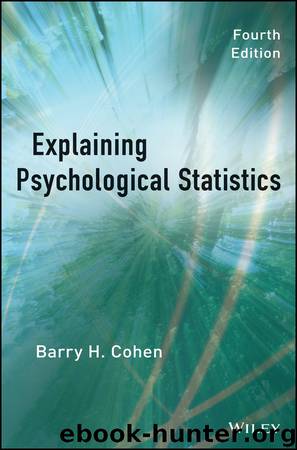Explaining Psychological Statistics by Cohen Barry H.;

Author:Cohen, Barry H.;
Language: eng
Format: epub
Publisher: John Wiley & Sons, Incorporated
Published: 2013-11-12T05:00:00+00:00
Interpreting Significant Results
Had we rejected the null, we could have concluded that the population means are not all the same, but we could not conclude that they are all different. We would need to conduct follow-up t tests to determine which pairs of population means are significantly different from each other (this will be explained in the next chapter). Moreover, because the three conditions were not created by the experimenter, rejecting the null would not mean that parental death causes changes in optimism. Alternative explanations are possible. For instance, pessimism may run in families, and pessimism may lead to poor health and early death. According to this hypothetical explanation, both the child's pessimism and the early parental death are caused by a third variable—that is, the parents' pessimism.
If the independent variable had involved an experimental manipulation (e.g., all subjects are given a “test” and then given randomly chosen feedback suggesting that their future job prospects are good, fair, or poor), significant differences in optimism between the (randomly assigned) groups could be attributed to the feedback manipulation. In this case, we might talk of the underlying population means being different, but we are not referring to actual populations; we are referring to theoretical populations (e.g., the mean of the population if everyone in the population had received positive feedback, the mean if everyone in the population had received negative feedback, etc.). To conclude that the population means are not all the same (i.e., reject the null hypothesis in a one-way ANOVA) in this case would be to say that the manipulation had some effect on optimism. To quantify the size of that effect, you will need to calculate an effect-size meaure like the ones described later in this section.
Download
This site does not store any files on its server. We only index and link to content provided by other sites. Please contact the content providers to delete copyright contents if any and email us, we'll remove relevant links or contents immediately.
Modelling of Convective Heat and Mass Transfer in Rotating Flows by Igor V. Shevchuk(6222)
Weapons of Math Destruction by Cathy O'Neil(5829)
Factfulness: Ten Reasons We're Wrong About the World – and Why Things Are Better Than You Think by Hans Rosling(4487)
Descartes' Error by Antonio Damasio(3164)
A Mind For Numbers: How to Excel at Math and Science (Even If You Flunked Algebra) by Barbara Oakley(3103)
Factfulness_Ten Reasons We're Wrong About the World_and Why Things Are Better Than You Think by Hans Rosling(3046)
TCP IP by Todd Lammle(3012)
Applied Predictive Modeling by Max Kuhn & Kjell Johnson(2907)
Fooled by Randomness: The Hidden Role of Chance in Life and in the Markets by Nassim Nicholas Taleb(2860)
The Tyranny of Metrics by Jerry Z. Muller(2846)
The Book of Numbers by Peter Bentley(2779)
The Great Unknown by Marcus du Sautoy(2536)
Once Upon an Algorithm by Martin Erwig(2473)
Easy Algebra Step-by-Step by Sandra Luna McCune(2467)
Lady Luck by Kristen Ashley(2410)
Practical Guide To Principal Component Methods in R (Multivariate Analysis Book 2) by Alboukadel Kassambara(2379)
Police Exams Prep 2018-2019 by Kaplan Test Prep(2355)
All Things Reconsidered by Bill Thompson III(2261)
Linear Time-Invariant Systems, Behaviors and Modules by Ulrich Oberst & Martin Scheicher & Ingrid Scheicher(2231)
